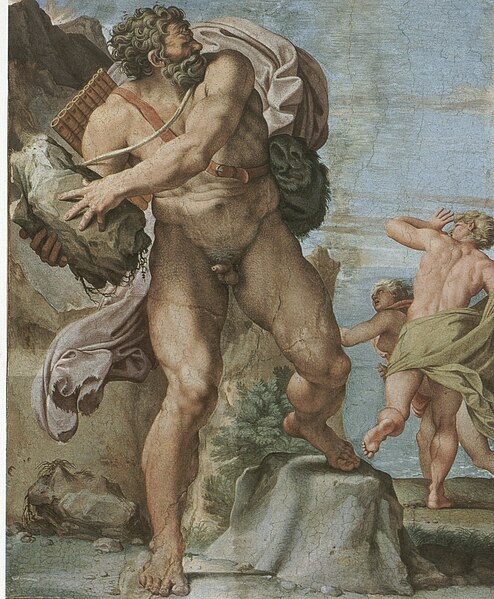Among the myriad of creatures and monsters of Greek mythology, one stands out with a singular, piercing eye: Polyphemus. This cyclopean giant has fascinated many, and today, we’ll delve deep into his story.
Polyphemus Key Facts
| Origin | Cyclops |
| Creator | Poseidon, the god of the seaand Thoosa |
| Defeated by | Odysseus |
| Habitat | Island of the Cyclopes |
| Other names | None |
| Roman name | Polyphemus |
| Associated with | Sheepherding, Isolation |
| Symbols | Single Eye, Sheep, Cave |
Name and Etymology
Polyphemus, a name that resonates with mystery and power. The name itself is of Greek origin, meaning “much spoken of” or “famous.” In Roman mythology, he retains the same name, a testament to his notoriety across cultures. Over time, various epithets and titles have been associated with him, but none as iconic as the one-eyed giant or the son of Poseidon.
While the name Polyphemus is unique, Cyclopes, One-Eyed Giant Monsters, in general, have been referred to by various names in different tales. The term “cyclops” itself is derived from the Greek words “kyklos” (circle) and “ops” (face), alluding to the single round eye these giants possess. Such etymological insights offer a glimpse into the ancient world’s fascination with these creatures.
The Roman counterpart of Greek mythology often has different names for similar entities. However, in the case of Polyphemus, the Romans were so captivated by his tale that they kept his name unchanged. This consistency across cultures speaks volumes about the giant’s impact on ancient civilizations.

Polyphemus Origin and Creation
The origins of Polyphemus are as intriguing as the tales that surround him. Born to the god of the sea, Poseidon, and the nymph Thoosa, Polyphemus was destined for greatness (or perhaps notoriety). As a cyclops, he belonged to a group of primordial giants, each possessing a single eye in the center of their forehead.
Why did such beings come into existence, you ask? Well, the cyclopes, including Polyphemus, were created as craftsmen for the gods. They were skilled blacksmiths, forging powerful weapons and tools. However, over time, their narrative evolved, and they became known more for their brute strength and less for their craftsmanship.
The early existence of Polyphemus is shrouded in myths and tales. While many stories revolve around his later life, particularly his encounter with Odysseus, The Cunning Hero Of The Trojan War, his early days are less documented. However, it’s believed that he lived a rather isolated life, tending to his sheep on the Island of the Cyclopes, away from the meddling of gods and men.
Depiction And Characteristics
Imagine a towering figure, muscles rippling, with a single, large eye staring down at you. That’s Polyphemus for you. This cyclopean giant, often depicted with rough, weathered skin, was a force to be reckoned with. His sheer size and strength made him a formidable being, but it was his singular eye that became his defining feature.
Associated with him are the sheep he so lovingly tended. These creatures, often seen grazing around him in artworks, symbolize his somewhat peaceful nature (until provoked, of course). His dwelling, a large cave, also plays a significant role in his tales, becoming both his home and his prison.
Polyphemus Nature and Behavior
Despite his fearsome appearance, Polyphemus was, at heart, a simple shepherd. He cared for his flock, leading them to graze and ensuring their safety. However, this doesn’t mean he was entirely benign. When provoked, his wrath was legendary, as Odysseus and his crew would attest.
The Ancient Greeks perceived him as a representation of the untamed wilderness, a being that stood in stark contrast to the civilized world. His isolation and somewhat naive nature made him vulnerable, but also unpredictable. One moment he might be serenading a nymph with his songs, and the next, he could be hurling boulders at intruders.
Polyphemus Abilities
Being a cyclops, Polyphemus possessed immense strength. This was evident in his daily tasks, from moving large boulders to seal his cave, to effortlessly capturing and devouring his prey. His single eye, while a vulnerability, also gave him a unique perspective, quite literally.
However, his abilities weren’t just physical. Polyphemus also showcased a deep connection with his surroundings, understanding the moods of the sea and the patterns of the land. This connection, stemming from his lineage and his life as a shepherd, made him a formidable being, not just in strength but in understanding the world around him.
Polyphemus Symbols or Associations
The single eye of Polyphemus is undeniably his most iconic symbol. Representing both his strength and vulnerability, this eye has become synonymous with the cyclopes. But there’s more to him than just that eye. His association with sheep, for instance, showcases his pastoral life and his deep connection with nature.
Another symbol closely tied to Polyphemus is the cave he inhabited. This cave, often depicted in art and literature, represents both shelter and isolation. It’s a place of safety, but also a prison of sorts, especially when the cunning Odysseus traps him within.
Polyphemus and Odysseus
The tales surrounding Polyphemus are numerous, but one stands head and shoulders above the rest: his encounter with Odysseus, as vividly depicted in Homer’s epic ‘The Odyssey’. As Odysseus journey home from the Trojan War, fate led him to the island of the Cyclopes. Drawn by the allure of a cave brimming with provisions, he and some of his crew ventured inside, unaware of the danger that lurked.
The cave’s inhabitant, Polyphemus, returned from his daily tasks to find these uninvited guests. In a shocking twist, defying the age-old customs of hospitality, the giant trapped them inside by placing a massive stone at the entrance. Without a shred of mercy, he devoured two of Odysseus’ men, setting a grim tone for their captivity.
As dawn broke, Polyphemus indulged in his gruesome habit again, consuming two more men. But by evening, Odysseus, ever the tactician, had a plan. He offered the giant wine, a potent brew he had received earlier in his travels. The unsuspecting Polyphemus, unaccustomed to the strength of the undiluted wine, became intoxicated. In his inebriated state, he inquired about Odysseus’ name. Cunningly, Odysseus introduced himself as “Οὖτις” or “Nobody.”
The wine and the conversation took their toll, and as Polyphemus succumbed to sleep, Odysseus and his men executed their plan. They took a wooden stake, previously hardened in the fire, and blinded the one-eyed giant. The pain was excruciating, and Polyphemus’ cries of agony echoed throughout the island. When other giants came to his aid, all they heard was that “Nobody” was harming him. Misinterpreting it as a divine affliction, they left him, advising prayer as the remedy.
Odysseus and his men escapes
The following morning, as Polyphemus let his sheep out, he felt their backs, ensuring no men were atop. But Odysseus’ cunning shone again. He and his crew clung to the undersides of the sheep, evading the giant’s touch and making their escape.
However, as they sailed away, Odysseus’ pride got the better of him. He revealed his true identity, an act of hubris that would have repercussions. Enraged, Polyphemus hurled massive rocks at Odysseus’ ship, which they narrowly dodged. The giant then beseeched his father, Poseidon, to avenge him, setting in motion a series of events that would further challenge the already beleaguered hero.
Representations Of Polyphemus In Art
The tale of Polyphemus and Odysseus has been a favorite among artists for centuries. From ancient pottery showcasing the blinding of the cyclops to Renaissance paintings depicting the dramatic escape, the story has been told and retold through art.
One particularly striking representation is Annibale Carracci’s “Polyphemus Furioso.” This masterpiece captures the blinded Polyphemus hurling rocks at Odysseus and his men as they make their escape.

Mentions in Ancient Texts
Polyphemus’ tale is ancient, and as such, it finds mention in several classical texts. The most notable of these is Homer’s “Odyssey,” where the encounter with the cyclops forms a pivotal part of Odysseus’ journey home. Written around the 8th century BC, this epic poem delves deep into the Psyche, The Deification Of The Human Soul of both the hero and the monster.
Another mention can be found in Virgil’s “Aeneid.” While not as detailed as the Odyssey, it offers a different perspective on the cyclops, painting him in a more sympathetic light.
To quote the “Odyssey”: “Cyclops, if any one of mortal men shall ask thee about the unsightly blinding of thine eye, say that Odysseus, the sacker of cities, blinded it, even the son of Laertes, whose home is in Ithaca.”
Frequently Asked Questions
The most renowned story is his encounter with Odysseus, where the hero outsmarts him and escapes from his cave.
Polyphemus resided on the Island of the Cyclopes, leading a pastoral life as a shepherd.
He was the offspring of Poseidon, the god of the sea, and the nymph Thoosa.
No, there were other cyclopes, but Polyphemus is the most famous due to his encounter with Odysseus.
Odysseus blinded him by driving a sharpened stake into his single eye.
Yes, his most iconic symbols are his single eye, sheep, and the cave he inhabited.
Featured Image Credit: Jacob Jordaens, Public domain, via Wikimedia Commons
